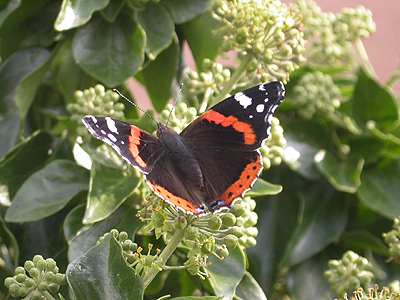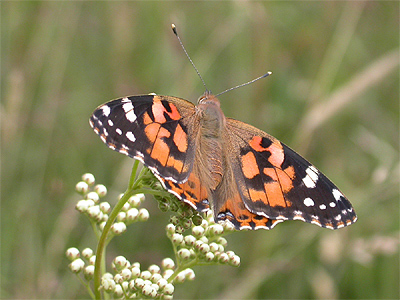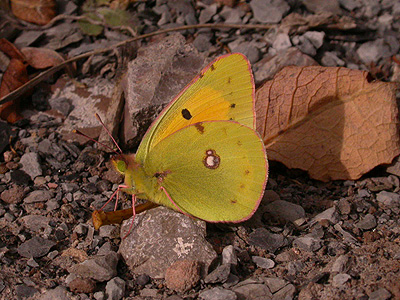

| A summary of the migrant Butterfly records from Eakring 1998-2010 | ||||
| This page is largely based upon old notebook records and is as complete as possible. Many daily single records of both of the Nymphalids were not written up at the time and are missing from the records summaries. Records from 2001 onwards are complete summaries. The main three migratory species are detailed first, but it is less well known that other species migrate as well and details of these are given in the lower section of this page. | ||||
| ... |
| Red Admiral Vanessa atalanta |
| 2010 The only Spring
record was of an adult at Park Farm on 12/06/10. A female
was noted egg laying at Oil Bore Holes in Eakring village
on 03/07/10. Autumn migration was poor, with single
adults noted moving south on 18/09/10, south-east
22/09/10 and south-east 30/09/10. October sightings
included two moving south 04/10/10, two moving south-west
08/10/10, one moving south 10/10/10 and one moving south
11/10/10. 2009 Generally a very poor year, although bigger numbers were expected to coincide with the massive Painted Lady influx this year. There were no Spring records and the first at Eakring were two moving south-west 09/08/09; Small numbers only, seen during August and September, with three moving south on August 9th; One near Lound Wood on 29/10/09 was the last of the year. |
||||
| ... | ||||
| 2008 Another early first date, when an
adult was seen flying across the road near Tug Bridge
Farm on February 9th. The next record was not until one
on Mill Lane, Eakring on May 10th. There were very few
sightings during the Autumn, with just singles at Hare
Hill Wood on 08/06/08 and moving south over Red Hill on
14/09/08. Seven went south over Red Hill on 14/09/08. 2007 One moving north-west over Red Hill on February 4th was exceptionally early and presumed to have over-wintered nearby. There was a number of similar records across much of the county since the New Year. During the rest of the year, sightings included single adults at Eakring Flash and Lound Wood on 01/07/07, but then no others were seen until September, when adults were at Hare Hill Wood and Eakring Meadows on 01/09/07, at Park Farm on 08/09/07 and Red Hill on 13/09/07. Adults were noted moving south at Red Hill on 29/09/07, with two moving south there on 30/09/07. |
 |
|||
| ... | ||||
| 2006 Arrival was from
17/06/06, with an adult near Red Hill. The only other
Spring record was of two moving north over Red Hill
18/06/06, although a worn adult at Eakring Flash
11/07/06, may have been a late Spring migrant. Second
brood Red Admirals began emerging from mid-July and
Autumn records consisted of an adult moving south
22/07/06; An adult moving south-west 25/07/06; Five in
the area 21/09/06; 12 moving south 24/09/06; 11 moving
south 25/09/06; Five at Eakring village 07/10/06; Two
moving south, Red Hill 13/10/06 and three moving south
22/10/06. Latest ever sightings included a single at Hare
Hill Wood on November 5th, with two there on November
6th. 2005 Arrival on May 15th with an adult at Eakring Flash. Further records followed towards the end of the first week of June. There were no August records at all, due to lack of coverage. All 2005 records included - Adult at Eakring Flash 15/05/05; Adult at Eakring Flash 05/06/05; Adult at Eakring Flash 18/06/05; One moving north 20/06/05; Adult at Eakring Flash 22/06/05; Adult at Eakring Flash 29/06/05; Adult at Eakring Flash 30/06/05; Adults at Hare Hill Wood (one) and two at Eakring Meadows (including one north) 03/07/05; One at Lound Wood 11/07/05; One at Hare Hill Wood 14/07/05 2004 A new earliest arrival date was set, with an adult at Eakring village on April 9th, which beat the previous record of 23/04/03 by a considerable margin. Whether this was an over-wintering adult is unknown. More likely, was that it was a direct result of an unusually early arrival of migrant butterflies and moths along the UK's south coast in early February. Further records during 2004 followed over three months later, when more adults arrived in the area from late June. Sightings included an adult at Church Hill on June 27th and at Red Hill on July 1st. An adult was near Eakring Flash on 06/08/04. A poor showing for return migrants followed in September, with two moving south (3rd) and three moving south (4th) 2003 First adult was a single in Lound Wood on the earliest ever date of April 23rd and appeared in almost immaculate condition. There were butterflies noted on most dates during the period April 23-October 16th and many of these were adults moving south-west through the area on return migration. A largest-ever daily count of 134 migrants was reached on August 3rd. In addition 47 flew south on September 20th. Large numbers were noted around Eakring village on September 14th and daily passage continued thoughout September, with butterflies passing through at a rate of one every three-five minutes on favourable days. A roost was found early morning at Hare Hill Wood September 20th, when 52 Red Admirals were sunning themselves just after first light within a 10 metre stretch of woodland edge. Daily movement from August 4th onwards (mostly ones and twos moving south-west) increasing during second week of September. 47 south on September 20th. Still common at Ivy into early October. 2002 First of the Spring period occurred at Eakring Flash on May 27th, an individual remaining until June 1st. The only other records for the period, involved adults at the same site on June 24th and July 4th. These latter two individuals, possibly referring to late migrants. First fresh individuals, resulting from earlier breeding in the area, included singles at Eakring Flash on both July 10th and 13th. Autumn migrants included just six adults moving south between August 16-September 19th. 2001 Small numbers noted throughout the traditional flight periods. A late adult was in the pastures area on October 7th. 2000 First adults of the year were two moving north-east (June 18th) followed by four the next day. The Autumn provided regular counts of actively migrating Red Admirals between August 20-September 30th, with 135 adults counted during the period. This peaked at a record 82 south on September 30th. This event and quantity is probably not entirely unusual during good invasion years and was witnessed from a vantage point on Red Hill, during a three hour watch in the early afternoon period, which followed an overcast and misty morning. Much of the total consisted of loose groups of up to seven butterflies at a time and with regular frequency. All were found to be flying at a steady height, which was noticed to be maintained, despite the differences in ground contour and altitude at various points along the hill. Generally, butterflies flew into the wind, but migration was most often recorded when winds were light and south-westerly. 1999 First adults were noted on one Spring date (June 26th) Late migrant noted moving north-east on on July 11th, with 2nd instar larvae found a week later on July 18th. The late-Summer/Autumn period produced a total of 48 adults, recorded moving either south or south-west during the period August 1-25th, with a peak of 22 south on August 25th. 1998 Two moving south and two other adults in the area on August 8th, was the year's only record. |
||||
| ... | ||||
| Painted Lady Vanessa cardui |
| Painted Lady
butterflies continued to move through Eakring on the
afternoon of 29/05/09, although in much reduced numbers
than the previous afternoon. Movements today were
generally straight WNW, but there appeared to be a
definite south-easterly movement into the wind today,
something that was not noted yesterday. A total of 728
Painted Ladies were recorded. We again made counts of
five minute periods from 14:25h - 15:50h. There was also
a distinct decline in movement throughout the watch.
Numbers peaked between 60 and 70 per five minutes,
between 14:35h and 15:05h, dropping to between 38 and 45
from 14:55h and 15:30h. The last four five minute counts
produced counts between 12 and 21, so there was a clear
drop in movement. Movements in the south of the UK appear
to have dried up, but Painted Ladies are still continuing
to move further north. Movement continued on 30/05/09,
but had slowed considerably. Still, 191 moving west would
have represented an enormous Spring count on recent
years. Return movement was eagerly anticipated, but turned out to be a very low key affair and it seems much of the UK missed the main event. The first were three moving south on 06/08/09, followed a few days later by 12 moving south on 08/08/09. The peak seems to have come the very next day, when we counted 93 moving south-west on 09/08/09 and these remained the last Painted Ladies of the year. 2007 An extremely poor year, with just two sightings of worn adults at Eakring Meadows and Hare Hill Wood on 07/07/07. Evidence that butterflies did indeed move through earlier, was the third instar larva found at Eakring Flash on 12/07/07. |
||||
| ... | ||||
| 2006 Painted Ladies were
late arriving in 2006 and inclusive Spring arrivals
occurred from June 10-18th. Spring records were; An adult
near Eakring Flash on 10/06/06 being the first of the
year. Adults at Red Hill and Church Hill 17/06/06; Adult
at Eakring Flash and one moving north 18/06/06. A fresh
adult was at Eakring Flash on 11/07/06 and larval webs
(empty and occupied) were very common thoughout the area
during early July. Autumn records included an adult
moving south-west 22/07/06; Three moving south and
south-west 25/07/06; 45 at Oil Bore Holes 29/07/06; Two
at Eakring village 21/09/06. There were two late records
in October - One nectaring at Ivy, Kneesall Road
07/10/06; One nectaring on Bramble, Red Hill 13/10/06,
was a new latest ever date. 2005 The only record for the year was of an adult near Eakring Flash on May 31st. 2004 A disappointing year after an arrival of three adults at Eakring Meadows on 12/06/04. Other sightings during the year were 21 at three sites (including 19 along Mill Lane) on 14/08/04, an adult near Eakring Flash on 22/08/04 and an adult moving south 03/09/04. The last report concerned one in Eakring village on 04/09/04. |
 |
|||
| ... | ||||
2003 Three around Red Hill on May 24th were the first arrivals into the area, coming prior to a good influx/arrival around May 31st, with adults still common at most sites by mid-June. Near full-grown larvae found commonly at Hare Hill Wood on Spear Thistle (Cersium vulgare), June 29th. Good numbers around Eakring Flash on August 2nd, with over 30 present during a quick count. This preceeded a record 716 south-west on August 3rd. Scaled up to cover the entire length of the recording area, the estimated number of Painted Ladies would have been a minimum of 12 500 in around six hours. Butterflies were also noted moving at Rutland Water in Leicestershire, but there were no reports coming from anywhere else in the UK, although this was clearly a country-wide event. A count of 67 was made along a 100 metre stretch of Mill Lane on August 8th, dropping to eight at the same site on August 13th. Small numbers in area, often going several days without any sightings at all until eight in Eakring village on September 14th, indicating a second small influx/emergence. Last Painted Lady of 2003 was one at Red Hill on October 12th. 2002 A single at Eakring Flash on May 23rd, represented a new earliest date for the species and the only record for the first part of the year. Autumn records. Good numbers emerging from around August 8th onwards. Individual records include one on August 16th. There were no records until two at Eakring Flash and Red Hill on September 10th. 2001 A very poor year with no records. 2000 First butterflies of the Spring were four at various locations within the area on June 18th (an unusual count for the time of year and probably representative of a decent influx this year) These were followed up by a single on the June 19th, with all Spring records involving short-staying butterflies. Return migration in the Autumn, occurred between August 20th and September 9th (seven adults) Despite a good Spring showing, Autumn counts were very much on a smaller scale to that of the Red Admiral. 1999 There were no Spring records and the only records came during the late Summer/Autumn period, when singles were recorded on the following two dates - at Oil Bore Holes on August 14th and moving south-west September 12th. 1998 Four were in Eakring village on September 8th, being the only record of the year. |
||||
| ... | ||||
| Clouded Yellow Colias crocea |
The only occurrences to date came during the large influx of 2000, when the area produced four records followed by a single record in 2004. All but one of these were adults observed on a genuine return migration. 2004 The first record since 2000, was of an adult flying south through the Oil Bore Holes site on 03/09/04 2000 First Clouded Yellow records for the area, starting with an adult at Eakring Meadows Nature Reserve on 29/08/00 which appeared very freshly emerged. Further migrants were recorded later in the year moving south over Red Hill (19/09/00) and again on 23/09/00. Another single headed south-east at Tug Bridge Farm on 30/09/00. |
 |
|||
| Potential
migrants/species often associated with periods of
migration It's not always well known that other species migrate as well as the three detailed above, but certainly when there is a large scale movement of Painted Ladies, other Nymphalids and Whites will be recorded as well. |
||
| Large
White Pieris
brassicae |
||
| 2009 Probably as a direct result of
immigration during the Spring, Large Whites were abundant
in what was generally another good year for our native
butterflies. Several counts of 500+ were made throughout
the area during July, but 109 were counted moving
south-west with Painted Ladies on 09/08/09. 2003 Migrant Large Whites moved through in August, during a period of very hot weather. A large movement was evident with 179 south-west on 03/08/03, followed over the next few days by 36 south-west on 04/08/03 and then eight south-west on 06/08/03, with all movements coinciding with large numbers of Painted Ladies. |
||
| Small
White Pieris
rapae |
||
| 2003 Totals included 54 south-west on 03/08/03, followed by seven south-west on 04/08/03 and three south-west on 06/08/03. | ||
| Green-veined
White Pieris
napi |
||
| 2003 Movement included 42 south-west on 03/08/03, with only very small numbers on 04/08/03 and 06/08/03. A total of 50 migrants. | ||
| Peacock
Inachis
io |
|||
| 2009 47 moving
south-west on 09/08/09, coincided with a good return
movement of Painted Ladies and Large Whites. 2003 During the Spring, odd Peacocks were noted moving purposefully north, but little attention to the thought of them being migrants was given at the time. The early Autumn saw an unusual movement of 106 south-west on 03/08/03, took place in conjunction with several other species. The weather was very hot and dry at the time and this movement was thought to have been triggered by the very dry conditions. Six were noted the following day (04/08/03) and just two were recorded on 06/08/03. |
|||
| Small
Tortoiseshell Aglais
urticae |
|||
| 2003 Odd singles were noted moving through north during the Spring period, but were not thought of as being migrants at the time. In the Autumn, 47 moving south-west on 03/08/03 was a very high count, from a species not thought of as being a migrant. A further ten flew south-west again on 04/08/03, before another eight moving south-west on 06/08/03. | |||